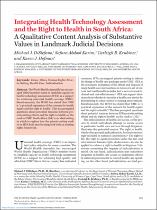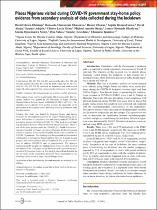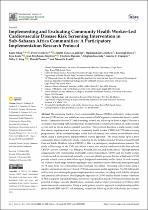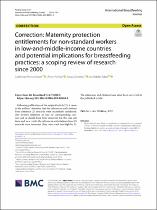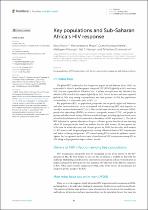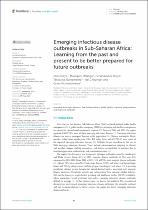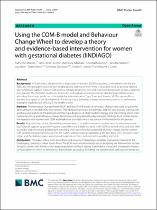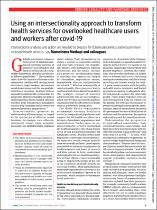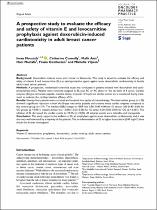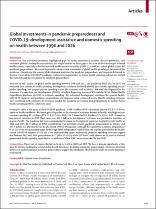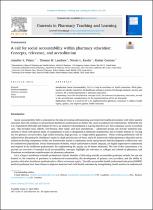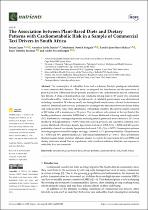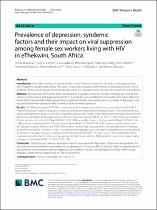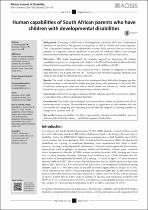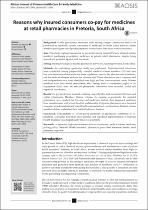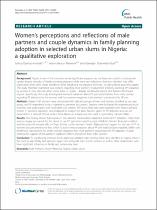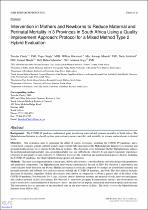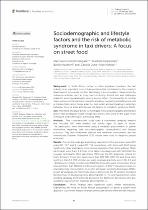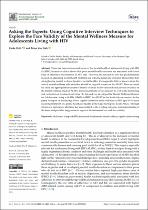School of Public Health
Browse by
With some exceptions, our work focuses on five inter-related programme areas – HIV/AIDS, TB, maternal and child health, public health nutrition, and non- communicable diseases – and three health systems areas which cut across all programmes – namely human resource development, health information systems and health promotion
Sub-communities within this community
Collections in this community
Recent Submissions
-
Integrating health technology assessment and the right to health in South Africa: a qualitative content analysis of substantive values in landmark judicial decisions
(Cambridge University Press, 2023)The World Health Assembly has encouraged WHO member-states to establish capacity in health technology assessment (HTA) as a support for achieving universal health coverage (UHC). Simultaneously, the WHO has stated that UHC ... -
Places Nigerians visited during covid-19 government stay-home policy: evidence from secondary analysis of data collected during the lockdown
(Page Press Publications, 2023)Introduction. Compliance with the Government’s lockdown policy is required to curtail community transmission of Covid-19 infection. The objective of this research was to identify places Nigerians visited during the lockdown ... -
Implementing and evaluating community health worker-led cardiovascular disease risk screening intervention in Sub-Saharan Africa communities: a participatory implementation research protocol
(MDPI, 2023)The increasing burden of non-communicable diseases (NCDs), particularly cardiovascular diseases (CVD) in low- and middle-income countries (LMICs) poses a considerable threat to public health. Community-driven CVD risk ... -
Correction: Maternity protection entitlements for non-standard workers in low-and-middle-income countries and potential implications for breastfeeding practices: a scoping review of research since 2000 (international breastfeeding journal, (2023), 18, 1, (9), 10.1186/s13006-023-00542-8)
(BioMed Central Ltd, 2023)Background: Following publication of the original article [1], it came to the authors' attention that the references and citations from reference 25 onwards were incorrectly numbered: (the former) reference 25 had no ... -
Key populations and Sub-Saharan Africa’s HIV response
(Frontiers Media S.A., 2023)Background: The global HIV epidemic has had the greatest impact on Sub-Saharan Africa (SSA). An estimated 67% of the 38.4 million people living with HIV (PLWH) globally in 2021 were from SSA. SSA was responsible for 670,000 ... -
Emerging infectious disease outbreaks in Sub-Saharan Africa: Learning from the past and present to be better prepared for future outbreaks
(Frontiers Media S.A., 2023)Background: Over the past two decades, Sub-Saharan Africa (SSA) has faced multiple public health emergencies (1). A public health emergency (PHE) is a situation with health consequences too severe for conventional community ... -
Using the com-b model and behaviour change wheel to develop a theory and evidence-based intervention for women with gestational diabetes (iindiago)
(BioMed Central Ltd, 2023)Background: In South Africa, the prevalence of gestational diabetes (GDM) is growing, concomitant with the dramatically increasing prevalence of overweight/obesity among women. There is an urgent need to develop tailored ... -
Using an intersectionality approach to transform health services for overlooked healthcare users and workers after covid-19
(BMJ Publishing Group, 2022)Background: Globally, government responses to the covid-19 pandemic reinforced prevailing patterns of privilege and prejudice and further entrenched the inequitable distribution of health and disease in different populations. ... -
A prospective study to evaluate the efficacy and safety of vitamin E and levocarnitine prophylaxis against doxorubicin-induced cardiotoxicity in adult breast cancer patients
(SAGE Publications Ltd, 2023)Background: Doxorubicin induces acute and chronic cardiotoxicity. This study is aimed to evaluate the efficacy and safety of vitamin E and levocarnitine (EL) as cardioprotective agents against acute doxorubicin cardiotoxicity ... -
Global investments in pandemic preparedness and COVID-19: development assistance and domestic spending on health between 1990 and 2026
(Elsevier Ltd, 2023)Background: The COVID-19 pandemic highlighted gaps in health surveillance systems, disease prevention, and treatment globally. Among the many factors that might have led to these gaps is the issue of the financing of ... -
A call for social accountability within pharmacy education: concepts, relevance, and accreditation
(Elsevier, 2023)Introduction: Social accountability (SA) is a leap to excellence in health education. While pharmacists are ideally situated in the healthcare setting to practice SA through research, service, and practice, SA is ... -
The association between plant-based diets and dietary patterns with cardiometabolic risk in a sample of commercial taxi drivers in South Africa
(MDPI Journal, 2023)The consumption of unhealthy foods and a sedentary lifestyle predispose individuals to non-communicable diseases. This study investigated the distribution and the association of plant-based diets (PBDs) and dietary patterns ... -
Prevalence of depression, syndemic factors and their impact on viral suppression among female sex workers living with HIV in eThekwini, South Africa
(BMC women's health, 2023)Introduction Over half of female sex workers (FSW) in South Africa are living with HIV and clinical depression has been frequently documented among FSW. Data characterizing structural determinants of depression and the ... -
Human capabilities of South African parents who have children with developmental disabilities
(Aosis, 2023)Background: Parenting a child with a developmental disability (DD) has a substantial influence on the lives of the parents or caregivers, as well as on how the family operates. This is frequently because of the adjustments ... -
Reasons why insured consumers co-pay for medicines at retail pharmacies in Pretoria, South Africa
(AOSIS, 2019)Costly prescription medicines with existing cheaper alternatives tend to be purchased by medically insured consumers of healthcare. In South Africa medical scheme members pay higher out-of-pocket payments for medicines ... -
Women’s perceptions and reflections of male partners and couple dynamics in family planning adoption in selected urban slums in Nigeria: A qualitative exploration
(BMC, 2014)Nigeria is one of the countries where significant progress has not been recorded in contraceptive uptake despite decades of family planning programs while there are indications that slum dwellers may differ significantly ... -
Intervention in mothers and newborns to reduce maternal and perinatal mortality in 3 provinces in South Africa using a quality improvement approach: Protocol for a mixed method type 2 hybrid evaluation
(JMIR Publications, 2023)The COVID-19 pandemic undermined gains in reducing maternal and perinatal mortality in South Africa. The Mphatlalatsane Initiative is a health system intervention to reduce mortality and morbidity in women and newborns ... -
Sociodemographic and lifestyle factors and the risk of metabolic syndrome in taxi drivers: A focus on street food
(Frontiers Media, 2023)In South Africa, similar to other populous countries, the taxi industry is an important form of transportation that contributes to the country’s development. As a result, minibus taxi driving is an occupation characterized ... -
Asking the experts: Using cognitive interview techniques to explore the face validity of the mental wellness measure for adolescents living with HIV
(MDPI, 2023)There has been an increased focus on the mental health of adolescents living with HIV (ALHIV), because evidence shows that poor mental health outcomes are associated with lower rates of adherence and retention in HIV care. ... -
Contraceptive service uptake and delivery preferences in perinatally and horizontally infected female adolescents living with HIV: Results from a South Africa-based mixed-methods study’
(Elsevier, 2022)To investigate whether contraceptive service uptake (including current contraceptive use), unmet need for contraception, unintended pregnancy, preferences for service provision, and providers among female adolescents ...

